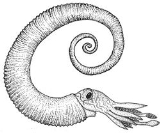
Turrilitaceae
Encyclopedia
The Turrilitacaeae is a diverse superfamily of Cretaceous ammonites generally considered as heteromorphic and commonly included in the suborder Ancyloceratina
. Shells of this diverse group do not coil planospirally, as typical for most ammonites
, but rather take on a variety of unique forms.
Some, such as the eponymous Turrilites
, coiled helically, like an auger shell, while others, such as Hamites
, had shells with long straight sections, while the one-of-a-kind Nipponites
coiled in a way so as to appear as a ball of knots.
As with other ammonites, the last of the Turrilitaceae had perished by the end of the Cretaceous during the Cretaceous–Tertiary extinction event.
Ancyloceratina
The Ancyloceratina were a diverse suborder of ammonite most closely related to the ammonites of order Lytoceratina. They evolved during the Late Jurassic but were not very common until the Cretaceous period, when they rapidly diversified and become one of the most distinctive components of...
. Shells of this diverse group do not coil planospirally, as typical for most ammonites
Ammonitida
The Ammonitida is an order of more highly evolved ammonoid cephalopods from the Jurassic and Cretaceous time periods, commonly with intricate ammonitic sutures....
, but rather take on a variety of unique forms.
Some, such as the eponymous Turrilites
Turrilites
Turrilites is a helically coiled ammonoid cephalopod from the lower part of the Upper Cretaceous ; generally included in the Ancyloceratina. Previously it was included in the ammonoid suborder, Lytoceratina....
, coiled helically, like an auger shell, while others, such as Hamites
Hamites
Hamites is a genus of heteromorph ammonite that evolved late in the Aptian stage of the Early Cretaceous and lasted into the Cenomanian stage of the Late Cretaceous. The genus is almost certainly paraphyletic but remains in wide use as a "catch all" for heteromorph ammonites of the superfamily...
, had shells with long straight sections, while the one-of-a-kind Nipponites
Nipponites
Nipponites is an extinct genus of heteromorph ammonites. The species of Nipponites are famous for the way their shells form "ox-bow" bends, resulting in some of the most bizarre shapes ever seen among ammonites.The ecology of Nipponites, as with many other nostoceratids, is subject to much...
coiled in a way so as to appear as a ball of knots.
As with other ammonites, the last of the Turrilitaceae had perished by the end of the Cretaceous during the Cretaceous–Tertiary extinction event.

